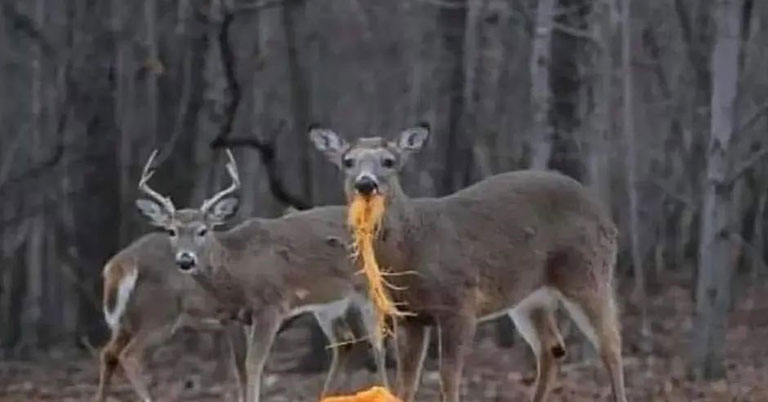
A Viral Facebook Post Suggests Leaving Pumpkins For Wildlife To Eat – Is It A Good Idea?
- Thomas Nelson
- September 22, 2023
- Animals
- 0 Comments
In recent years, a viral trend has taken the internet by storm, promoting the seemingly heartwarming idea of leaving old pumpkins in nature for wildlife to feast upon. Social media platforms have been flooded with images of pumpkins left in nature and accompanied by well-intentioned captions about supporting local wildlife.
While the concept may appear eco-friendly and compassionate at first glance, there is a pressing need to delve deeper into the implications of this trend and explore why it may not be the best idea for our environment and the creatures it sustains.
Are pumpkins good for wildlife?
Leaving old pumpkins in nature with the intention of providing wildlife with a food source might seem like a well-intentioned act of kindness. However, there are compelling reasons why this practice is not recommended:
Leaving human-produced food, like old pumpkins, in natural habitats can lead to habituation in wildlife. Habituation occurs when animals become accustomed to human-provided food, altering their natural behaviors and reliance on wild forage. This also increases the likelihood that they’ll have dangerous run-ins with people. If larger animals like bears and deer get habituated to human food in areas where we hike and drive, it increases the likelihood that people or wildlife could be injured or killed.
Rotting pumpkins can attract various wildlife, including raccoons, rodents, and other scavengers. While some may consider these animals fascinating, they can disrupt local ecosystems and create conflicts with human residents.
Leaving discarded pumpkins in natural areas contributes to litter and detracts from the natural beauty of the environment. Pumpkins are not native to most ecosystems and can disrupt the balance of local flora and fauna. It’s also unpleasant to stumble upon rotting food along hiking trails and in other places where it doesn’t belong.
Instead of providing old pumpkins, consider offering wildlife natural food sources like seeds, nuts, and native plants. These options align more closely with the animals’ natural diets and behaviors.
While the intention to support wildlife is commendable, leaving old pumpkins in nature can have unintended consequences. It’s essential to prioritize the well-being of local ecosystems and wildlife by adopting responsible and informed feeding practices that promote natural behaviors and maintain environmental balance.
How long does it take pumpkins to biodegrade?
Pumpkins, like other organic materials, can take longer to biodegrade in nature than one might initially assume. Organic material breaks down quickly in a compost heap due to the conditions we create artificially in said heaps. The forest floor doesn’t necessarily have those same conditions. The decomposition rate of a pumpkin depends on various factors, including environmental conditions, size, and the presence of microorganisms. Here are some general estimates:
In colder climates or during the winter months, pumpkins can take several months to over a year to fully biodegrade. Cold temperatures slow down the decomposition process. In warmer and more humid environments, pumpkins can decompose more quickly. In some cases, they may break down within a few months, especially if they are exposed to rain and moisture.
The size of the pumpkin also plays a role. Smaller pumpkins will typically decompose faster than larger ones because they have a greater surface area relative to their volume, making them more accessible to decomposers. The specific location where the pumpkin is left can also influence decomposition. Pumpkins placed in natural woodland settings with rich microbial communities may biodegrade more efficiently than those left in dry, arid environments.
It’s important to note that even when a pumpkin appears to have mostly disintegrated, some residue, such as seeds or thicker rinds, may persist for an extended period. Ultimately, the complete biodegradation of a pumpkin is a gradual process influenced by environmental factors. To minimize environmental impact and avoid attracting unwanted wildlife, it’s best to dispose of pumpkins properly, such as through composting or municipal yard waste programs, rather than leaving them in nature.
What about letting them rot in my yard?
Letting pumpkins rot in your own yard, as opposed to leaving them in a natural area, can be a more responsible and environmentally friendly choice for several reasons.
In your own yard, you have better control over the location where you allow the pumpkins to decompose. You can choose a spot that is away from sensitive ecosystems, water bodies, and high-traffic areas, minimizing potential environmental impact. If it doesn’t decay well, you can also easily clean it up yourself. Placing pumpkins in your yard reduces the likelihood of attracting unwanted wildlife to natural areas. By keeping the decomposition process closer to your home, you can better manage interactions with wildlife and avoid potential conflicts.
Pumpkins are excellent additions to compost piles. Their organic matter breaks down over time, contributing to the creation of nutrient-rich compost. This compost can be used to fertilize your garden, reducing the need for synthetic fertilizers and promoting sustainable gardening practices. Composting pumpkins in your yard reduces the amount of organic waste going to landfills. Organic waste in landfills generates methane, a potent greenhouse gas. By composting or allowing pumpkins to decompose on your property, you help reduce methane emissions.
While allowing pumpkins to rot in your own yard is a responsible choice, it’s essential to follow local regulations and guidelines for yard waste disposal. Some communities may have specific rules for the disposal of organic materials, so be sure to comply with local ordinances and recommendations.
What are better ways to get rid of old pumpkins?
There are several responsible and environmentally friendly ways to dispose of old pumpkins rather than leaving them in nature:
- Composting: Composting is one of the most sustainable methods of disposing of old pumpkins. Pumpkin scraps can be added to a compost pile or bin, where they will decompose naturally and contribute valuable nutrients to the soil. Make sure to chop the pumpkins into smaller pieces to expedite decomposition.
- Municipal Yard Waste Collection: Many communities offer yard waste collection services, especially in the fall. Check with your local government or waste management company to see if they accept pumpkins as part of their yard waste program. Be sure to follow any guidelines they provide for pumpkin disposal.
- Backyard Burial: If you have a garden or outdoor space, you can bury old pumpkins in your yard. Dig a hole deep enough to accommodate the pumpkins, place them in the hole, and cover them with soil. Over time, the pumpkins will decompose and enrich the soil.
- Animal Feed: Consider donating your old pumpkins to local farms or animal sanctuaries. Many farm animals, such as pigs, chickens, and goats, enjoy eating pumpkins as a nutritious treat. Contact local farmers or animal rescue organizations to inquire if they would like your pumpkins.
- Food Bank Donations: If the pumpkins are still in good condition, consider donating them to local food banks or community organizations. Some food banks accept fresh produce donations, including pumpkins, to distribute to individuals and families in need.
- Halloween Activities: Before disposal, you can get creative with your old pumpkins. Carving them into jack-o’-lanterns, using them for autumn decorations, or hosting pumpkin-themed activities can be a fun and sustainable way to make the most of your pumpkins.
- Farm Animal Treats: If you know someone who raises farm animals, ask if they would like your old pumpkins as treats for their livestock. Many farm animals enjoy pumpkins as a nutritious addition to their diets.
By choosing one of these responsible disposal methods, you can ensure that your old pumpkins are put to good use, whether by enriching the soil, providing sustenance for animals, or benefiting your local community. This approach not only reduces waste but also contributes positively to the environment and the well-being of others.

